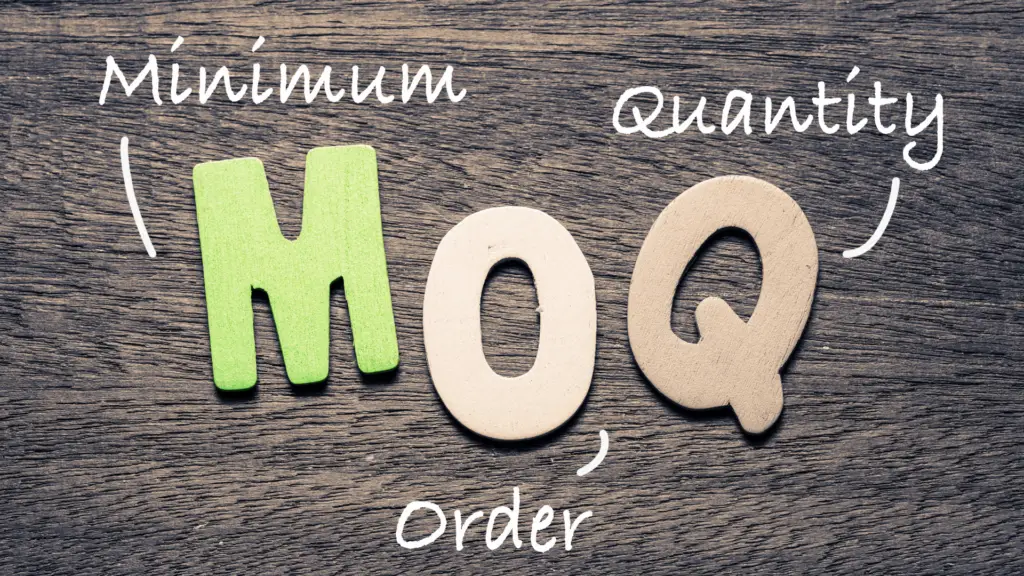In the world of business and manufacturing, the term Minimum Order Quantity (MOQ) frequently surfaces. For those new to the concept, understanding what MOQ means and stands for, its implications, how to calculate it, and how it affects different sectors can be vital to successful operations. This blog will dive deep into the nuances of MOQ, its importance in various industries, and how businesses can navigate it effectively. We’ll be discussing:
- What Does MOQ Mean?
- Types of MOQ
- How to Calculate MOQ
- What MOQ stands for in Different Industries
- Navigating MOQ: Tips for Business
- How to Manage MOQ through Inventory Management Software
What Does MOQ Mean?

MOQ stands for Minimum Order Quantity. It is the smallest quantity of a product that a supplier is willing to sell. Suppliers set this parameter to ensure that their production and operational costs are covered, and it also helps optimize their inventory management. By setting an MOQ, suppliers can achieve economies of scale, reducing the per-unit cost of production. Additionally, MOQs help suppliers manage their cash flow more effectively by ensuring a minimum revenue threshold. This strategy also enables suppliers to allocate resources more efficiently, balancing production schedules and inventory levels.
Why is MOQ Important?
MOQs play a pivotal role in maintaining a balance between supply and demand. They help suppliers manage their production schedules and inventory levels efficiently. Here are some key reasons why MOQs are important:
Cost Management
Setting an MOQ helps suppliers manage their production costs. Suppliers can achieve economies of scale by ensuring a minimum number of orders, reducing the per-unit production cost. This not only makes the pricing more competitive but also allows suppliers to allocate resources more efficiently. Additionally, predictable order volumes help suppliers negotiate better rates with their raw material providers, further lowering overall costs.
Related Read: How to Calculate Cost Per Unit
Inventory Control
MOQs aid in better inventory management. Suppliers can predict their production needs and avoid overproduction or stockouts, which can be costly. By maintaining optimal inventory levels, businesses can minimize storage expenses and reduce the risk of deadstock. Additionally, accurate inventory forecasting based on MOQs ensures a smoother supply chain operation, enhancing overall business efficiency.
Supplier-Buyer Relationships
MOQs can influence the dynamics between suppliers and buyers. Understanding the rationale behind MOQs can lead to better negotiations as buyers can secure more favorable terms while suppliers can optimize production efficiency, fostering long-term, mutually beneficial partnerships.
Types of MOQs
Minimum Order Quantities can differ significantly depending on the product type and industry. Below are common types of MOQs:
- High MOQ: High MOQs are typically required for products that involve substantial investment in raw materials and complex production processes. For example, electronics manufacturers often set high MOQs due to the expensive components and intricate assembly required. High MOQs help suppliers cover production costs and ensure profitability.
- Low MOQ: Low MOQs are usually offered by suppliers targeting small businesses or startups. These suppliers might be new to the market and open to smaller orders to establish relationships and increase market share. Low MOQs provide startups with the opportunity to test products without the need for large commitments.
- No MOQ: Some suppliers, particularly in the service or digital product sectors, may not impose an MOQ. This option is appealing for businesses that need flexibility in their order quantities. With no MOQ, companies can scale orders according to demand, avoiding the risks of overstocking.
| Type | Reason | Example | Benefits |
|---|---|---|---|
| High MOQ | Complex production, high-cost components | Electronic manufacturers | Manages production costs, ensures profitability |
| Low MOQ | Targets smaller businesses | New market entrants | Allows startups to test products, builds relationships |
| No MOQ | Service industries, digital products | SaaS providers | Flexibility in scaling orders, avoids excess inventory |
How to Calculate MOQ

Determining the Minimum Order Quantity is crucial for optimizing inventory management, ensuring cost efficiency, and maintaining supply chain balance. Here’s a step-by-step guide on how to calculate MOQ:
Determine Product Costs:
Start by identifying all costs involved in producing your product. This includes raw materials, labor, and overhead costs like utilities or equipment depreciation. Don’t forget packaging costs, such as materials and design, and include shipping costs for getting the product from the manufacturer to your warehouse.
Calculate Fixed Costs:
Fixed costs are expenses that don’t change with the production volume. This includes setup fees for production runs, such as mold or machine setup costs, as well as administrative expenses related to order processing and inventory management.
Estimate Demand:
Use historical sales data to estimate how many units you expect to sell over a specific period, like a month or a year. Market research can help you refine these estimates by considering trends and external factors that could impact future demand.
Determine Inventory Holding Costs:
Inventory holding costs cover the expenses of storing your products, like warehouse rent and utilities. You should also factor in insurance to protect your inventory against risks like damage or theft.
Analyze Supplier Requirements:
Understand your supplier’s minimum order requirements, as these will influence your MOQ. If your supplier offers volume discounts for larger orders, factor these into your calculations to potentially lower your per-unit cost.
Calculate the Desired Profit Margin:
Decide on the profit margin you aim for by determining the markup needed over your costs. Then, set your selling price based on this margin, considering market prices and competitor pricing.
Calculate MOQ Using the Formula:
Use the formula to determine the minimum number of units you need to meet your cost and profit goals:
MOQ = (Fixed Costs + (Variable Costs per Unit * Expected Demand)) / (Selling Price per Unit – Variable Costs per Unit)
Review and Adjust:
After calculating your MOQ, review it to ensure it aligns with your business goals. Conduct a break-even analysis to ensure your order quantity is sufficient to cover costs and deliver your target profit. Adjust as needed, possibly negotiating with suppliers for better terms or factoring in seasonal demand fluctuations to optimize inventory levels throughout the year.
Factors Influencing MOQ
Several factors influence the determination of minimum order quantity:
- Production Costs: The cost of raw materials, labor, and machinery directly affects the MOQ and how to calculate it. Higher production costs typically stand for higher MOQs, as suppliers need to offset these expenses and ensure a profitable production run. Economies of scale often dictate that larger orders are more cost-effective.
- Shipping Costs: Shipping costs play a significant role in setting MOQs. Suppliers need to ensure that shipping smaller quantities does not erode their profit margins. By setting higher minimum order quantity, suppliers can reduce the per-unit shipping cost and improve overall profitability.
- Inventory Levels: Suppliers need to maintain optimal inventory levels to meet demand without incurring excessive storage costs. This balance influences the MOQ set by the supplier, as holding large amounts of stock can be costly and affect cash flow. Proper inventory management helps avoid overstocking and stockouts.
- Market Demand: Historical data and market forecasts help suppliers set MOQs that align with demand patterns. Seasonal variations and trends are also considered in this calculation, ensuring that the order quantity supports both current and anticipated market needs. Accurate demand forecasting minimizes the risk of unsold inventory.
Related Read: Inventory Management Best Practices
Challenges of Minimum Order Quantity

- Barriers for Small Businesses: High MOQs can be a significant obstacle for small businesses or startups with limited budgets. These businesses may struggle to enter the market or expand their product offerings due to the inability to meet high order requirements. This makes it difficult to compete with larger companies that can easily meet such demands. Offering lower order quantity or flexible terms can enable small businesses to scale and grow more effectively.
- Customer Satisfaction: Setting MOQs too high can discourage existing customers from placing orders, potentially leading to a loss of business. It’s essential to strike a balance that meets the needs of both the supplier and the customer. A manageable order quantity that aligns with production and profitability goals helps maintain strong customer relationships and ensures ongoing sales.
What MOQ stands for in Different Industries
Minimum Order Quantity plays a crucial role across various industries, but its application can differ depending on the specific sector. Here’s how it is typically understood in manufacturing, wholesale, and retail.
What MOQ Stands for in Manufacturing
In manufacturing, MOQ refers to the smallest number of units a manufacturer is willing to produce in a single run. This is often influenced by the setup costs associated with production, which can be significant. For example, a company producing custom T-shirts might require a minimum order of 500 units to justify the cost of creating custom screens for printing. This MOQ ensures that the manufacturer can cover the setup costs and still achieve a profit.
What MOQ Stands for in Wholesale
In wholesale, the minimum order quantity represents the minimum quantity a wholesaler will sell to a retailer or another buyer. This is typically set to ensure that the transaction is worthwhile for the wholesaler, considering storage and handling costs. For instance, a wholesaler dealing in electronic gadgets might have an MOQ of 50 units per order. This allows the wholesaler to maintain a streamlined operation and ensures that the purchase is large enough to justify the logistics involved.
What MOQ Stands for in Retail
In retail, MOQ is often used in the context of suppliers setting minimum purchase requirements for retailers. Retailers, in turn, may set their order quantity when dealing with customers. For example, an online clothing store might require customers to purchase a minimum of three items to qualify for free shipping. This strategy helps the retailer manage shipping costs effectively and encourages customers to buy more.
Navigating MOQ: Tips for Businesses
Negotiation
Negotiating MOQs with suppliers can sometimes lead to more favorable terms. Businesses should communicate their needs and explore options like mixed orders to meet MOQs without overcommitting. This approach helps in maintaining a balance between meeting supplier requirements and managing inventory effectively.
Building Relationships
Long-term relationships with suppliers can lead to more flexible MOQ terms. By building trust and demonstrating consistent business, companies can encourage suppliers to offer better terms and adapt to their specific needs. Strong relationships often result in improved collaboration and more advantageous conditions.
Alternative Suppliers
If a supplier’s MOQ is too high, businesses can explore alternative suppliers with lower MOQs. This strategy is especially useful for startups aiming to manage cash flow and reduce inventory risks. Finding suppliers with more accommodating terms can help maintain financial stability and ensure smooth operations.
Related Read: 5 Inventory Management Mistakes Businesses Make
How MOQ Impacts Inventory
- Stock Levels: MOQ helps maintain a minimum inventory level to prevent stockouts and ensure consistent product availability. However, high MOQs can lead to excess inventory if demand is overestimated, increasing storage costs and the risk of products becoming obsolete.
- Order Frequency: High MOQs often result in placing fewer but larger orders, which can reduce ordering frequency and lower administrative costs. However, these larger orders may require more storage space, leading to potential challenges in managing inventory space efficiently.
- Cash Flow: Meeting high MOQ requirements requires significant upfront capital, which can strain cash flow and limit funds available for other business activities. On the positive side, ordering in larger quantities can offer benefits like bulk discounts and lower per-unit costs, which can enhance profitability.
- Inventory Turnover: MOQs directly influence inventory turnover rates. Large MOQs can slow turnover if products do not sell quickly, leading to aging stock and increased holding costs. Properly managing order quantity to align with demand can improve turnover rates, ensuring fresher inventory and lower carrying costs.
- Supplier Relations: Consistently meeting MOQ requirements can strengthen supplier relationships, potentially providing leverage for better terms, discounts, or priority service. However, rigid order quantity may reduce flexibility in inventory management, making it challenging to adapt to sudden changes in demand or supply chain disruptions.
How to Manage MOQ through Inventory Management Software

Using inventory management software can streamline the process of managing Minimum Order Quantities and ensure efficient stock control. Here’s how you can leverage these tools:
- Set Limits: Configure minimum order quantities for each product in the software, ensuring orders meet supplier requirements. Set automatic alerts for when stock levels approach or fall below these thresholds.
- Track Inventory: Monitor inventory levels in real-time to prevent stockouts and overstock situations. Use historical data to adjust order quantities based on sales trends and seasonal demand.
- Automate Reordering: Define reorder points to trigger automatic purchase orders when a stock reaches predefined levels. Connect with suppliers through the software to maintain compliance with order quantities.
- Forecast Demand: Use sales forecasting tools to predict future sales and adjust order quantities accordingly. Analyze sales trends and market conditions to make informed adjustments on how to calculate MOQ.
- Optimize Stock Levels: Maintain safety stock to handle demand fluctuations and supply chain disruptions. Generate inventory reports to assess turnover rates and align order quantities with market conditions.
- Streamline Order Processing: Manage purchase orders, supplier interactions, and inventory receipts efficiently. Handle backorders and stock shortages by adjusting order quantities based on availability.
- Review and Adjust: Regularly update order quantities based on changes in supplier terms, market demand, and inventory performance. Use software analytics to evaluate and refine your strategy.
Conclusion
Understanding what MOQ stands for, how to calculate it, and how it impacts business operations is crucial for effective supply chain management. By comprehensively analyzing production costs, market demand, and supplier capabilities, businesses can navigate the complexities of order quantity to optimize their operations.
For businesses looking to streamline their inventory and order management, tools like Vencru can be invaluable. Vencru offers robust inventory management solutions that can help you set reorder points, track inventory levels, and ensure you never miss a sale due to stockouts. By leveraging Vencru’s features, businesses can efficiently manage their supply chain, making order management seamless.
Related Content






